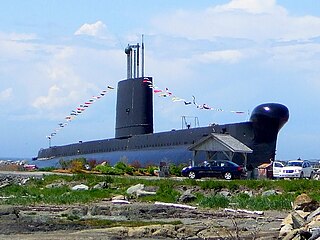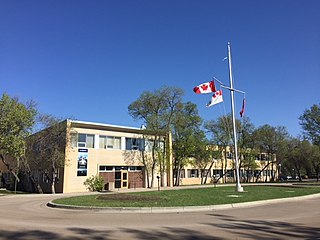
HMCS Onondaga (S73) is an Oberon-class submarine that served in the Royal Canadian Navy and later the Canadian Forces. Built in the mid-1960s, Onondaga operated primarily with the Maritime Forces Atlantic until her decommissioning in 2000 as the last Canadian Oberon.

HMCS Nipigon was an Annapolis-class destroyer that served in the Royal Canadian Navy and later the Canadian Forces. She was the second Canadian naval unit to carry this name. Entering service in 1964, she was named for the Nipigon River that flows through Ontario.

The Royal Naval Canadian Volunteer Reserve (RNCVR) was a naval reserve that was established in Canada in May 1914 and existed until 1923. Initially divided into three subdivisions stretching across the nation, the RNCVR could serve either with the Royal Canadian Navy or the Royal Navy during wartime. During the First World War, an Overseas Division was created and by the end of the war, over 8,000 men served either in Canadian service or abroad. Following the war, the reservists were demobilized and Canada's volunteer reserve was reorganized into the Royal Canadian Naval Volunteer Reserve.
HMCS Sault Ste. Marie was a reciprocating engine-powered Algerine-class minesweeper built for the Royal Canadian Navy during the Second World War. Entering service in 1943, the minesweeper was used as a convoy escort in the Battle of the Atlantic. Following the war, the minesweeper saw service as a training vessel before being scrapped in 1960.

The Canadian Forces Naval Reserve is the Primary Reserve component of the Royal Canadian Navy (RCN). The primary mission of the NAVRES is to force generate sailors and teams for Canadian Armed Forces (CAF) operations, including: domestic safety operations as well as security and defence missions, while at the same time supporting the Navy's efforts in connecting with Canadians through the maintenance of a broad national presence.
The Porte-class gate vessels were a class of five boom defence vessels built in the early 1950s and operated by the Royal Canadian Navy (RCN) and Canadian Forces (CF) during the Cold War. The class derived its name from the gates of the French fortifications of Québec and Louisbourg and was designed by the RCN as a replacement for World War I-era Battle-class trawlers used to operate anti-submarine booms during World War II. The Porte class were used primarily as training vessels during the Cold War.

HMCS Queen is a shore based Canadian Forces Naval Reserve unit based in Regina, Saskatchewan. This is one of two in Saskatchewan, the other being HMCS Unicorn in Saskatoon, Saskatchewan. Located at 100 Navy Way, the ship's name derives from the literal translation of the Latin word 'regina' which means 'queen.'

HMCS Hunter is a Canadian Forces Naval Reserve Division (NRD) located in Windsor, Ontario. Dubbed a stone frigate, HMCS Hunter is a land-based naval training establishment crewed by part-time sailors and also serves as a local recruitment centre for the Canadian Forces Naval Reserve. It is one of 24 naval reserve divisions located in major cities across Canada.

HMCS Brunswicker is a Canadian Forces Naval Reserve Division (NRD) located in Saint John, New Brunswick. Dubbed a stone frigate, HMCS Brunswicker is a land-based naval training establishment crewed by part-time sailors and also serves as a local recruitment centre for the Canadian Forces Naval Reserve and the Royal Canadian Navy (RCN). It is one of 24 naval reserve divisions located in major cities across Canada.
HMCS Cabot is a Canadian Forces Naval Reserve Division (NRD) located in St. John's, Newfoundland. Dubbed a stone frigate, HMCS Cabot is a land-based naval training establishment crewed by part-time sailors and also serves as a local recruitment centre for the Canadian Forces Naval Reserve. It is one of 24 naval reserve divisions located in major cities across Canada.
HMCS Cataraqui is a Canadian Forces Naval Reserve Division (NRD) located in Kingston, Ontario. Dubbed a stone frigate, HMCS Cataraqui is a land-based naval establishment for part-time sailors as well as a local recruitment centre for the Royal Canadian Navy (RCN). It is one of 24 naval reserve divisions located in major cities across Canada.
HMCS Griffon is a Canadian Forces Naval Reserve Division (NRD) located in Thunder Bay, Ontario. Dubbed a stone frigate, HMCS Griffon is a land-based naval establishment for part-time sailors as well as a local recruitment centre for the Canadian Naval Reserve. It is one of 24 naval reserve divisions located in major cities across Canada.
HMCS Radisson is a Canadian Forces Naval Reserve Division (NRD) located in Trois-Rivières, Quebec. Dubbed a stone frigate, HMCS Radisson is a land-based naval training establishment crewed by part-time sailors and also serves as a local recruitment centre for the Canadian Forces Naval Reserve. It is one of 24 naval reserve divisions located in major cities across Canada.
HMCS Jolliet is a Canadian Forces Naval Reserve Division (NRD) located in Sept-Îles, Quebec. Dubbed a stone frigate, HMCS Jolliet is a land-based naval training establishment crewed by part-time sailors and also serves as a local recruitment centre for the Canadian Forces Naval Reserve. It is one of 24 naval reserve divisions located in major cities across Canada.
HMCS Queen Charlotte is a Canadian Forces Naval Reserve Division (NRD) located in Charlottetown, Prince Edward Island. Dubbed a stone frigate, HMCS Queen Charlotte is a land-based naval training establishment crewed by part-time sailors and also serves as a local recruitment centre for the Royal Canadian Navy (RCN). It is one of 24 naval reserve divisions located in major cities across Canada.

Canadian Forces Auxiliary Vessel (CFAV) Badger (YAG-319) was one of ten wooden YAG-300 vessels built for the Royal Canadian Navy (RCN) between 1953 and 1955. Built for use as auxiliary craft, Badger primarily served as an at-sea training platform for junior naval officers, boatswains, reserve personnel and Sea Cadets at Canadian Forces Base (CFB) Esquimalt.

Canadian Forces Auxiliary Vessel (CFAV) Grizzly was one of ten wooden YAG 300 vessels built for the Royal Canadian Navy (RCN) between 1953 and 1955. Built for use as auxiliary craft, Grizzly primarily served as an at-sea training platform for junior naval officers, boatswains, reserve personnel and Sea Cadets at Canadian Forces Base (CFB) Esquimalt. Her name perpetuated the WWII armed yacht HMCS Grizzly was reused for PTC 60 GrizzlyOrca-class Patrol Craft Training (PCT) tender that replaced the YAG 300 vessels as the RCN training tenders in 2008.










